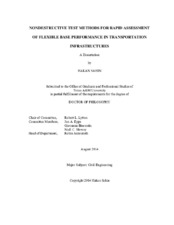| dc.description.abstract | Well-built roads with longer service life and lesser life cycle cost are the key to meet the desired target of satisfying the public without compromising the quality of roads. Roads that are constructed and built with poor quality materials and inadequate design considerations frequently require costly maintenance and rehabilitation often resulting in detours and lane closures, which not just reduce the comfort of the public but also interrupt the efficient flow of transporting goods, and hence the associated businesses. Therefore, it is imperative that alternative quality control and quality assurance methods along with effective test methods and smart transportation planning must be considered and implemented to help communities increase the economic prosperity while retaining and ensuring a high quality of life to the people.
The appropriate application of reliability to pavement design is essential to achieve the main objectives of designing quality pavements to serve the traveling public with comfort and safety while being durable in service at a minimum life cycle cost.
The quality of the base layer of the pavement, which is located directly beneath the surface, is one of the most critical components in designing a pavement with increased service life and durability. The base layer is primarily composed of aggregates and contributes to the structural stability of the pavement system by providing load transfer and support. A base course with adequate thickness and built with high quality aggregates is essential to meet the necessary performance criteria and in doing so will cut down on reconstruction cycles and cost of maintenance.
This research attempts to contribute in this regard by evaluating the significance of using the fundamental material properties to develop models which characterize the base layer in a pavement system. These new models will have significant contributions to soil mechanics and highway design procedures. This research and the developed models depend upon fundamental soil properties. This work capitalizes upon the fundamental properties to make extensive use of these models for quality control (QC) and quality assurance (QA), in the pre-design procedure and construction phase. The most significant impact of the work is to replace and improve current methods, increase work efficiency, minimize time spent in the laboratory, find more convenient relationships, reduce costs, and improve sustainability. In addition, the quickly and accurately measured aggregate characteristics of base courses will be used to determine the in-place and as-compacted design properties for QC and QA. | en |


